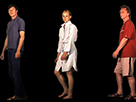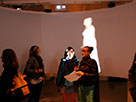|
|
Interactive video installation, 2014-2016
Acting: Heike Langsdorf, Maria Decorte, Alexander Baervoets, Reggy Timmermans, Julia Nitsberg, Heike Langsdorf, Maria Decorte, Alexander Baervoets, Reggy Timmermans, Julia Nitsberg, Helena Dietrich, Michael Buckley, Sue McCanley, Gregory Edelein, Bram Baloo, Celine Laloire, Ann Goovaerts, Loes Jacobs, Shelbatra Jashari, Vera Smirnova, Kurt Ryslavy, Boris Lehman, Cecile Guigny, Lisa Davies, Simon de Wrangel
Soundtrack composer: Guy de Bievre; Construction: Peter Maschke; Programmimg: Yacine Sebti; first version programming: Bart Vandeput
co-production:
The Vlaamse Overheid, la Fédération Wallonie-Bruxelles, VGC, Netwerk, iMAL, Nadine vzw, Adem vzw, Apass

 |
 |
 |
 |
Panorama is a new project in which the spectators can interact with the work in the immersive ambient environment. Exploiting the technology of 360-degree projection developed in the 50s, the artist sets out to utilize aspects of the surrounding environment as a vehicle for impacting on the audience both mentally and physically: the movements of the characters are designed to trigger the movement of the audience. The artist uses modern technology to explore the complexity of common behavioral patterns as well as the public’s “iconophilia”, or constant manic love for images.
Technical description:
3 video projectors fixed on a cyclorama side
8 speakers
kinect (attached to ceiling in the middle)
Light weight alluminium construction
(dark space)
As with all Dementieva’s installations this project is primarily geared towards the individual, and both the individual’s consciousness and unconsciousness. It is commonly acknowledged that everyone enjoys the spectacle of fire, especially its flames wavering in the wind, and that of the flow of water, be it a vigorous stream or a waterfall. With varying degrees of accuracy the interest of man in moving objects and images, described by the notion of scopokinephilia, is similar to a persistent attraction to these natural phenomena.
The installation with the difficult-to-pronounce title of “Cycloramadrome” is a rather risky experiment on the human mind. In this piece Dementieva diagnoses all humankind as suffering from scopokinephilia, and taking this as a premise for the piece, the artist (as always granting the viewer the right to choose) greatly reinforces both the effect of movement as well as all aspects of her diagnosis. This being the case, she even attempts to parody the very fact of scopokinephilia’s existence, something difficult to achieve in the genre of interactive installation.
The installation represents a circular panoramic view suspended in mid-air. Inside a video is shown. In order to watch the film the viewer has to enter the installation.
The protagonist of the film is a woman wearing a sexy white dressing gown who is continuously moving around in a circle with her motion accompanied only by the sound of her own steps. In essence this is a parody of typical scenes from thrillers and film noir about people with complicated identities, the characters of dark stories and horror films. During the monotonous walk of this sexually attractive blonde experiencing existential turmoil, other characters sporadically crop up around her, who not only do not join her but turn to the viewer to attentively examine him or her. An intricate construction of a double parody — in which the first imitates a cinematic trope intensifying its inherent feeling of anxiety, while the second involves scopokinephilia exercised in reverse, emerging from these secondary characters appearing out of nowhere and addressed to the viewer. Again, the piece makes the viewer both the main character of the installation and the subject of surveillance by these virtual people. Thus on opposite sides of the screen humans are indiscriminately infected by the mania of following. At the same moment that we are attentively watching those moving on the screen someone is following us and our actions.
Although there is nothing scary or particularly exciting in these rather monotonous scenes the feeling of anxiety is instilled in the viewer due to the fact that both mass media and the film industry make our collective memory susceptible to a vague sense of apprehension when faced with certain images.
Elena Selina
Interaction's modes
In all three parts we see the same three characters.
First mode - I named it cinematographic one, - is not interactive in sense of programming. The main personage (a blonde young lady), living through an existential drama, attracts a spectator in long observation, time by time provocative, then it replaced by anger and dissatisfaction and ends by a long Edvard Munch like scream. Its length is 15 minutes
Second mode is links to visitor's time inside of panorama. More he/she is watching the video, more differentpersonages arrive on screen, walking slowly and staring on a newcomer. Visitor becomes an actor and a main topic of observation by virtual people.
Third is divided in 4 parts (it correspondes to the lenth of film 15') following change in mood of the main character. The space inside panorama has three interactive zones. Each zone has its own script and its own heroes